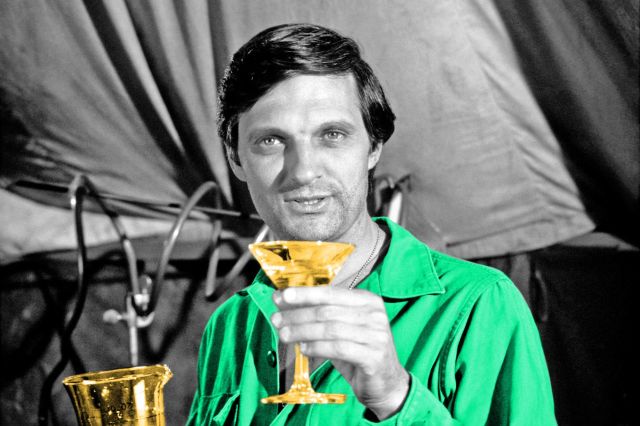
“M*A*S*H” Is Based on a True Story
M*A*S*H was loosely based on the 1970 Robert Altman film of the same name, which was an adaptation of the 1968 novel MASH: A Novel About Three Army Doctors, by Richard Hooker, the pen name of former U.S. Army surgeon H. Richard Hornberger. The Mobile Army Surgical Hospital, or MASH (the asterisks between the letters were a creative design element used in the fictional versions), was first deployed by the U.S. Army during World War II as an attempt to move surgical care closer to the wounded soldiers.
The charismatic character of Benjamin Franklin “Hawkeye” Pierce (played by Alan Alda) was created by Hornberger based on his own medical heroics. During the Korean War, Hornberger was assigned to the 8055th MASH, which traveled the 38th parallel dividing the Korean Peninsula, now the demilitarized zone that divides North and South Korea. His novel took 12 years to write and five years more to find a publisher, and eventually, Hornberger sold the television rights for the incredibly low amount of $500 (still only a few thousand dollars today) per episode.

Colonel Blake’s Death Was Kept a Secret From the “M*A*S*H” Cast
In the 1950s and ‘60s, death rarely came for popular television characters, and especially not the members of beloved sitcom ensembles. When actor McLean Stevenson told producers he would be leaving M*A*S*H after season three, the departure of his beloved character Colonel Henry Blake was originally planned as an earned discharge allowing him to return home. However, in continuing to push the envelope of television dramedy, Reynolds and Gelbart decided to kill off the colonel in the season finale, “Abyssinia, Henry.”
After first distributing the script without the final page and shooting all other scenes, Gelbart asked the cast to wait before starting the end-of-season wrap celebration. He then gave the actors a copy of the final page where Radar (played by Gary Burghoff) announces that Blake’s plane home has crashed. The final scene was filmed in two takes, capturing the immediacy of the actors’ emotions. Despite the groundbreaking nature of the episode, the decision proved controversial and CBS was inundated with complaint letters.

Only One Actor Appeared in Every “M*A*S*H” Episode
Despite the show’s success, and perhaps due to its long run, M*A*S*H experienced several significant cast changes, and several favorite characters were replaced with equally dynamic new ones — a standard practice on long-running shows today, but rare back then. In addition to Stevenson’s departure, Wayne Rogers (Captain “Trapper” John McIntyre) abruptly quit after season three, reportedly due to dissatisfaction with the development of his character. (Production planned a multimillion-dollar breach-of-contract lawsuit against the actor, but he revealed he never signed his contract, which made the matter moot.)
Stevenson’s Colonel Blake was succeeded by Colonel Potter (played by Harry Morgan), while B.J. Hunnicutt (played by Mike Farrell) took Trapper John’s place in the 4077th. Radar, the only main character transferred from the movie to the TV series, left the show in 1979.
Of the many actors who appeared on the show, Alda was the only star to appear in every episode. Through its run, the actor took increasing creative control of the series, directing 31 episodes including the finale, and co-writing 13 episodes. He became the first person ever to win Emmy Awards for acting, directing, and writing for the same show.
Loretta Swift (Margaret “Hot Lips” Houlihan) was a close second in terms of longevity; she appeared in all 11 seasons but missed a handful of episodes along the way.
More Interesting Reads

You Can Visit the Original Set Location
Before M*A*S*H, most sitcoms were filmed on stage sets in front of a live audience. To enhance the wartime realism of the show, exterior and tent scenes were shot on location in the mountains near Malibu, California.
On October 9, 1982, as the series was wrapping production, a sweeping brush fire destroyed most of the outdoor sets. The fire was written into the final episode as being caused by enemy bombs that forced the 4077th to move out. The site today is known as Malibu Creek State Park, and some of the original set locations are still intact and open to visitors.

The Cast Voted To End the Series
The actors worked closely as an ensemble and also became friends off-set. As Alda remembered, “Most of the time actors disperse and go to their dressing rooms between shots. We sat around in a circle of chairs making fun of one another, having fun.”
The cast was so close that they voted as a team to end the series; many of them believed they had exhausted all stories for their characters. The cast members who wanted to continue starred in the series AfterMASH, which ran from 1983 to 1985.

The Show Lasted Longer Than the Actual Korean War
In its first season, M*A*S*H aired on Sunday night against ABC’s Wonderful World of Disney. Ratings were near the bottom of the list and the series was almost canceled. In its second season, M*A*S*H was moved to the powerhouse CBS Saturday lineup, just after All in the Family, and followed by The Mary Tyler Moore Show, The Bob Newhart Show, and The Carol Burnett Show. As a result, M*A*S*H became one of the top 10 programs of the year and mostly stayed in the top 20 throughout the remainder of its 11-season run. This remarkable achievement far surpassed the span of the Korean War, which lasted just over three years (June 1950 to July 1953).











